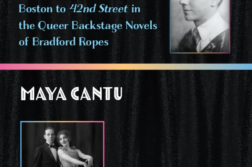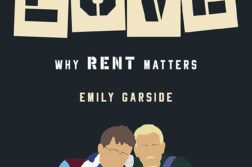The Nance
A play by Douglas Carter Beane
Produced by Lincoln Center Theater
THE BEST American history lesson in New York City is playing at the Lyceum Theatre on West 45th Street. The Nance, by playwright Douglas Carter Beane (The Little Dog Laughed), recalls the Depression-era burlesque stage where the stereotype of the simpering gay man—the eponymous title character—was a comic fixture whose risqué double-entendres in vaudeville sketches were matched by a lineup of chorus girls bumping and grinding to striptease music. Vaudeville and burlesque may have been on their way out, but they were popular enough with the urban masses for politicians to trawl for votes periodically by inveighing against their immorality.
Beane’s play packs gay social history and local Big Apple politics into his bittersweet dramatic comedy that has as its hero one Chauncey Miles, a successful burlesque actor known for his “nance” portrayals. Historically, most such gay caricatures were played by straight men—thus the “nance” was a gay figure similar to a minstrel show’s “blackface” performer. Beane has decided to layer the broad comic moments and the rueful ironies by having the homosexual Chauncey camp the burlesque nance more on-stage than off. His actual gay life is a sober study of the ins and outs of the closet. There is really only one major Broadway actor who could do the role justice, the irrepressible Nathan Lane, who has the manic chops and professional timing of an old vaudevillian combined with the gravitas of a tragedian.
The year is 1937. We first meet Chauncey at an automat in a beautifully rendered Art Deco period set where he’s eating a cheap meal while reading the paper and cautiously assessing the few single men cruising for company. A good-looking young man enters, sneaking a hot cup of water mixed with ketchup—an impromptu “tomato soup,” which identifies him as a hard-luck vagrant. Chauncey, ever-so-formal in his diction and dress and a self-identified Republican, strikes up a surreptitious conversation with the innocent fellow—aware that the cops have recently raided another local diner. Police methods were simple: charges of loitering were easily brought against men killing time, while charges of solicitation could likewise follow for those nervy enough to seduce other men with verbal entreaty. This opening scene is a subtle evocation of the canny underground codes by which gay men of the 1920s and ’30s negotiated their sex lives and at the same time created a sense of community. In his gentleman’s diction, Chauncey invites young “Ned”—new to town and sleeping on a park bench—to “meet me ’round the corner in a half-an-hour,” a phrase swiped from a burlesque ditty and used to avoid on-site assignations under the watchful gaze of plainclothes coppers.
The play moves along two simultaneous tracks. On one, Chauncey takes Ned under his wing, quickly getting him to stand in one night for a suddenly available burlesque role, while also having him share his apartment and bed. On the second, Beane presents the larger landscape against which this fraught love story takes place. New York’s Mayor Fiorello LaGuardia—the beloved “Little Flower” of the common folk—is preparing his next mayoral campaign and must appear to stamp out undesirable elements. This means cleaning up burlesque, ridding it of its “nance” characters with their off-color jokes and unseemly sight gags.
The love story starts with a kind of innocence and tenderness and moves toward something more complex. While Chauncey believes he has taken in straight “trade,” Ned explains that he was married upstate, but left his school sweetheart when he realized he had other “yearnings.” As Ned becomes a steady burlesque pro, he also finds in his domestic arrangement with Chauncey a partnered bliss of the kind he could only have dreamed about before. But a tidy marriage is far from Chauncey’s goal. While traveling as an itinerant vaudevillian, he always seeks the louche locales where the “boys meet the boys.” Beane gives us here a classic love dilemma, the mismatch between the one who loves fervently and desires domestic exclusivity and the one whose errant eye demands fresh excitement at every turn. As Ned, Jonny Orsini gives a sweet and solid accounting of a young man from the provinces learning the ropes and falling for an older guy who doesn’t so much sweep him off his feet as help him find his footing.
Although LaGuardia doesn’t appear as a character, his Republican world view threatens the very livelihood of the play’s main characters. The Lyceum turns into a burlesque house—the “Irving Place Theater”—with comic sketches and “exotic” dances performed by a cast of terrific hams and hoofers. Three female strippers—each with her own particular style and gambit—recall the trio of honky-tonk dancers in Jule Styne and Stephen Sondheim’s Gypsy. The most fully fleshed-out among them is Sylvie, a good-hearted Communist dame, played with winning brio by Cady Huffman, who’s a foil to Chauncey, the Roosevelt hater. The marvelous stalwart Lewis J. Stadlen plays Efram, the literal straight man to Lane’s limp-wristed nance. A hard-headed Jewish burlesque clown, Efram is neither in thrall to Sylvie’s Marxist enthusiasm nor easy about Chauncey’s queerness. For it is Chauncey Miles’s underground reputation as a queer playing a nance that brings in an enthusiastic money-paying crowd of boys-who-like boys. In the Irving Place Theater, in the upper balcony, they are pleasuring the “real” men who are excitedly ogling the gals stripping down to pasties and G-strings. Efram sees this unseemly behavior as a threat the authorities are sure to sniff out—bringing down the Irving Place’s entire house of cards.
Indeed, Chauncey is urged by Efram to tone down his nance routines until the worst of the surveillance blows over. This only encourages Chauncey’s most renegade impulses. No one is going to tamp down his sense of camp humor, especially since nothing obscene is taking place on stage. To Chauncey, it’s all in the audiences’ mind; each man and woman takes from his risqué puns what he or she will. Arrested by the cops for exceeding the limits, a courtroom scene gives Chauncey the opportunity to explain his “philosophy” about the burlesque performer and his public—its essential innocence. But Chauncey has finally misjudged his legal audience and misunderstood the times. For a moment, Beane seems to give us a whiff of Oscar Wilde speaking truth to power without realizing his guilt is a foregone conclusion. Chauncey is forced to do a brief spell behind bars, but the experience shakes him to the core—arousing the bitterness that he hides so well under the veneer of the nance’s comic bravado. As for the Irving Place Theater, it is the beginning of the end.
Beane brings a full measure of comedy and pathos to his tale, giving his cast a full palette of emotional colors with which to paint under the direction of Jack O’Brien. Its scenes move with swift assurance between backstage drama and onstage comedy. John Lee Beatty’s turntable of a set—one minute the stage at the Irving Place, next Chauncey’s apartment, and then the backstage wings of the Irving Place burlesque house—allows brisk cinematic pacing. And while this is no historical pageant, it draws a picture of an emerging gay world. Indeed, Beane’s protagonist’s first name is a nod to eminent Yale historian George Chauncey, author of Gay New York. The ensemble cast does it all—they sing, they dance, they tell jokes. And in Nathan Lane, they have a towering performance around which to strut their stuff.
Allen Ellenzweig is the author of The Homoerotic Photograph (1992) and a frequent contributor to this journal.





